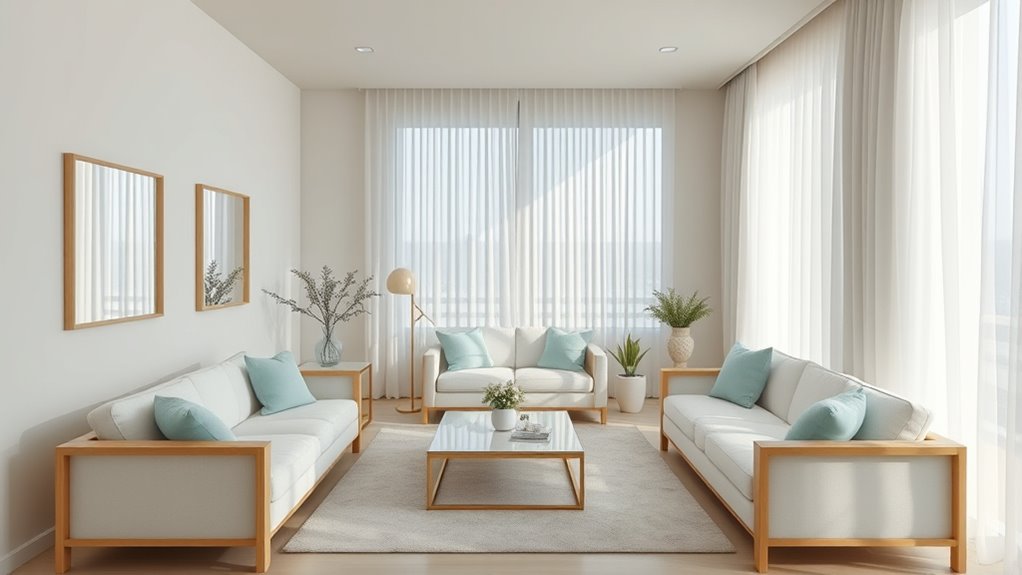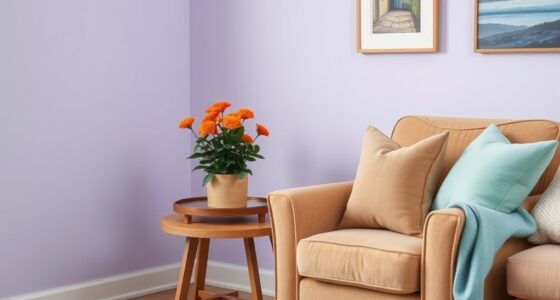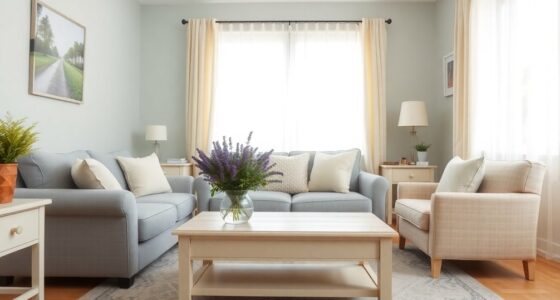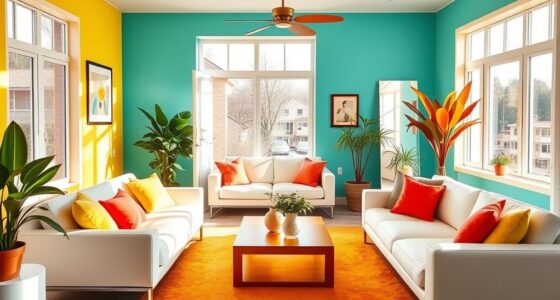Choosing light, neutral colors like whites, soft grays, or pastels can make your small space feel larger by reflecting more light and creating an airy atmosphere. Bright shades with a cool undertone work well to enhance openness, while dark or heavy hues tend to close in the space. To maximize the effect, combine your color scheme with good lighting and strategic furniture placement. Want tips on how lighting and furniture can further boost your space’s feel? Keep exploring.
Key Takeaways
- Use light, neutral colors like whites, creams, and pastels to reflect more light and create an airy feel.
- Incorporate monochromatic color schemes to enhance cohesion and visual expansiveness.
- Avoid dark or heavy hues that can make small spaces appear cramped and closed-in.
- Add accent colors sparingly to create focal points without overwhelming the room.
- Coordinate wall and ceiling colors to maximize light reflection and amplify the sense of space.
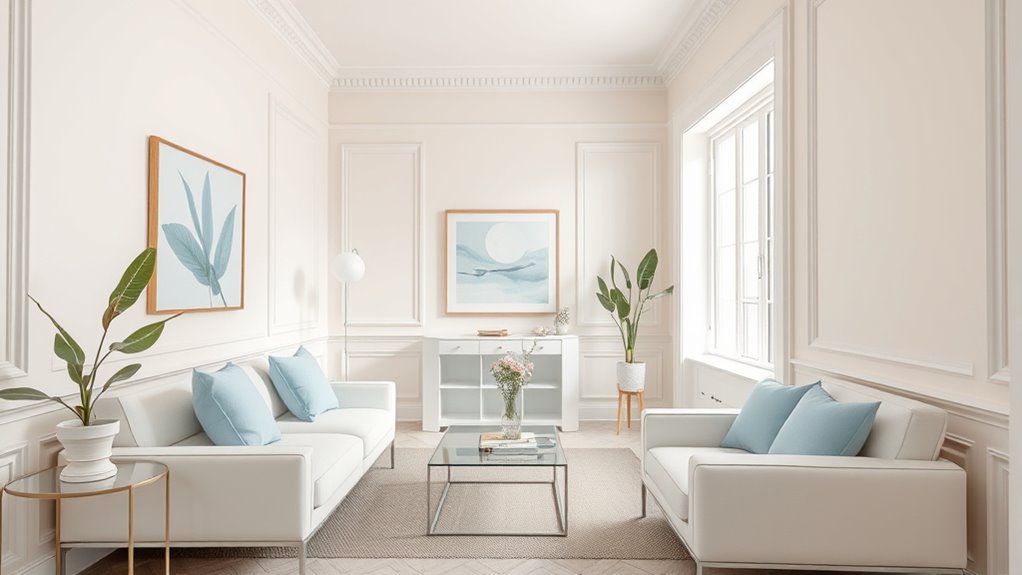
When designing a small space, choosing the right color scheme can make a significant difference in how open and inviting it feels. But beyond just colors, how you handle lighting options and furniture placement plays a vital role in maximizing the sense of space. Bright, natural light is your best ally. If possible, open up windows or keep window treatments light and breezy to let in as much daylight as you can. When natural light is limited, supplement with well-placed artificial lighting—think of layered lighting options like ceiling-mounted fixtures, wall sconces, and table lamps. These choices can eliminate shadows and create a bright, airy atmosphere that visually expands the room.
Your lighting choices don’t just affect brightness—they influence how spacious the room appears. Indirect lighting, such as LED strip lights or fixtures that bounce light off ceilings or walls, adds depth without clutter. Avoid overly heavy or dark fixtures that can make a space feel cramped or closed in. Keep light colors on the walls and ceiling to reflect more light, which enhances the feeling of openness. When you’re placing furniture, consider how your layout interacts with your lighting. Position larger pieces along the walls to keep the center of the room open, helping it look larger. Use multi-functional furniture that can serve dual purposes, reducing clutter and freeing up space to breathe.
Indirect lighting enhances space and depth, while light-colored walls reflect light to create an open, airy feel.
Furniture placement is key to creating the illusion of a larger room. Arrange your furniture to allow easy flow and clear sightlines across the space. Avoid blocking windows or light sources with oversized pieces, as this can cast shadows and make the room feel smaller. Instead, opt for low-profile furniture that sits close to the ground, which helps open up the vertical space and draws the eye upward. When you select furniture, think about scale and proportion; pieces that are too bulky can quickly overwhelm a small area, so choose sleek, streamlined designs. Keep a balance between furniture and open space—this prevents the room from feeling crowded and enhances your perception of size. Incorporating biodiversity-friendly elements like indoor plants can also improve the ambiance and air quality, making small spaces feel more lively and connected to nature.
In essence, the way you incorporate lighting options and furniture placement will dramatically influence how your small space feels. Thoughtful lighting illuminates every corner, making the room feel airy and expansive. Strategic furniture placement maintains openness and flow, preventing cluttered corners and creating a seamless, inviting environment. When you combine these elements with a well-chosen color scheme, you’ll transform even the tiniest room into a bright, welcoming space that feels much larger than it actually is.
Frequently Asked Questions
Can Dark Colors Make a Small Room Feel Bigger?
Dark colors can make a small room feel larger if you use them thoughtfully. According to color psychology, dark shades add depth and sophistication, while reducing visual weight. When paired with good lighting and strategic accents, these hues create an illusion of space. You should balance dark tones with lighter elements to avoid making the room feel cramped. So, yes, dark colors can enhance a small space when used correctly.
Do Patterns Affect the Perception of Space?
Patterns definitely affect your perception of space. Large-scale patterns can make a room feel more dynamic but might overwhelm small areas, while smaller patterns create a sense of cohesion and openness. The visual texture of a pattern adds depth without cluttering the space. By selecting patterns with appropriate scale and texture, you can make your room appear larger and more inviting, even with limited space.
How Does Lighting Influence Color Choices in Small Rooms?
They say, “Light is the mother of color,” and it’s true in small rooms. Natural light brightens space, making colors appear more vibrant and expansive. Artificial illumination, like soft white bulbs, can also enhance your chosen hues, creating an inviting atmosphere. When you combine good lighting with light, neutral tones, your small space feels larger and more open. Adjusting your lighting setup optimizes your color scheme and maximizes your room’s perceived size.
Are Neutral Colors Always Best for Small Spaces?
Neutral colors aren’t always the best choice for small spaces, but they do help create a calming, cohesive look. You can use color psychology to pick shades that boost mood and make the room appear larger. Focus on color coordination by adding accent hues or bold accessories to avoid a dull atmosphere. This approach keeps your space feeling open and inviting, while still expressing your style.
Can Accent Walls Help Expand a Small Room Visually?
Yes, accent walls can help visually expand a small room. You can use wall murals or color blocking to create a focal point that adds depth and dimension. For example, choosing a bold mural on one wall draws the eye and makes the space feel larger. Color blocking with lighter shades on surrounding walls can also enhance the sense of openness without overwhelming the room.
Conclusion
So, next time you’re feeling cramped, remember that choosing the right color scheme can actually make your small space seem bigger—ironic, isn’t it? Instead of knocking down walls, just paint them a light hue and watch the magic happen. Who knew that a simple coat of paint could be your best hack for a spacious feel? Sometimes, all it takes is a splash of color to turn a tiny room into a surprisingly airy retreat.
